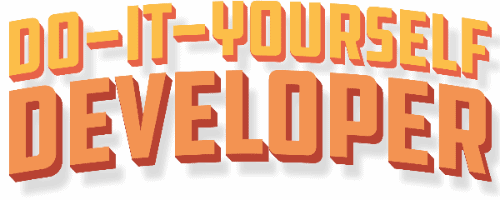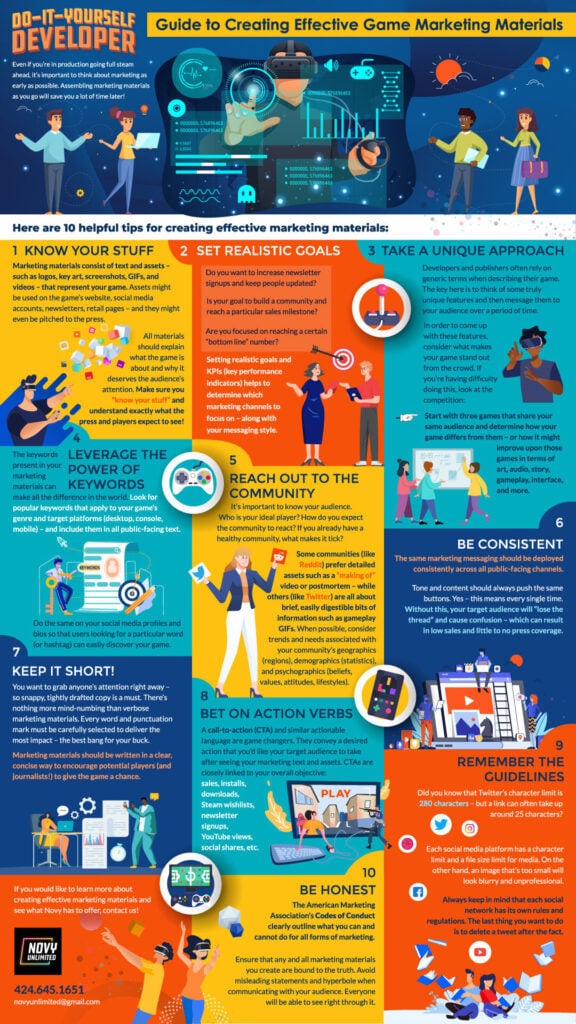“If you build it, they will come.” (Nope.)
Even if you’re in production going full steam ahead, it’s important to think about marketing as early as possible. Assembling marketing materials as you go will save you a lot of time later – when you’re ready to unveil your game to the world!
In this issue of Novy News, we’re featuring our newest infographic: “Do-It-Yourself Developer Guide to Creating Effective Marketing Materials.”
If you prefer the text-only version, read on.
Here are 10 helpful tips for creating effective marketing materials:
- Know Your Stuff
Marketing materials consist of text and assets – such as logos, key art, screenshots, GIFs, and videos – that represent your game. Assets might be used on the game’s website, social media accounts, newsletters, retail pages – and they might even be pitched to the press. All materials should explain what the game is about and why it deserves the audience’s attention. Make sure you “know your stuff” and understand exactly what the press and players expect to see!
- Set Realistic Goals
Do you want to increase newsletter signups and keep people updated? Is your goal to build a community and reach a particular sales milestone? Are you focused on reaching a certain “bottom line” number? Setting realistic goals and KPIs (key performance indicators) helps to determine which marketing channels to focus on – along with your messaging style.
- Take a Unique Approach
Developers and publishers often rely on generic terms when describing their game. The key here is to think of some truly unique features and then message them to your audience over a period of time. In order to come up with these features, consider what makes your game stand out from the crowd. If you’re having difficulty doing this, look at the competition: Start with three games that share your same audience and determine how your game differs from them – or how it might improve upon those games in terms of art, audio, story, gameplay, interface, and more.
- Leverage the Power of Keywords
The keywords present in your marketing materials can make all the difference in the world. Look for popular keywords that apply to your game’s genre and target platforms (desktop, console, mobile) – and include them in all public-facing text. Do the same on your social media profiles and bios so that users looking for a particular word (or hashtag) can easily discover your game.
- Reach out to the Community
It’s important to know your audience. Who is your ideal player? How do you expect the community to react? If you already have a healthy community, what makes it tick? Some communities (like Reddit) prefer detailed assets such as a “making of” video or postmortem – while others (like Twitter) are all about brief, easily digestible bits of information such as gameplay GIFs. When possible, consider trends and needs associated with your community’s geographics (regions), demographics (statistics), and psychographics (beliefs, values, attitudes, lifestyles).
- Be Consistent!
The same marketing messaging should be deployed consistently across all public-facing channels. Tone and content should always push the same buttons. Yes – this means every single time. Without this, your target audience will “lose the thread” – which can result in low sales and little to no press coverage.
- Keep It Short!
You want to grab anyone’s attention right away – which is why snappy, tightly drafted copy is a must. There’s nothing more mind-numbing than verbose marketing materials. Every word and punctuation mark must be carefully selected to deliver the most impact – the best bang for your buck. Marketing materials should be written in a clear, concise way to encourage potential players (and journalists!) to give the game a chance.
- Bet on Action Verbs
A call-to-action (CTA) and similar actionable language are game changers. They convey a desired action that you’d like your target audience to take after seeing your marketing text and assets. CTAs are closely linked to your overall objective: sales, installs, downloads, Steam wishlists, newsletter sign-ups, YouTube views, social shares, etc.
- Remember the Guidelines
Did you know that Twitter’s character limit is 280 characters – but a link can often take up around 25 characters? Each social media platform has a character limit and a file size limit for media. On the other hand, an image that’s too small will look blurry and unprofessional. Always keep in mind that each social network has its own rules and regulations. The last thing you want to do is to delete a tweet after the fact.
- Be Honest
The American Marketing Association’s Codes of Conduct clearly outline what you can and cannot do for all forms of marketing. Ensure that any and all marketing materials you create are bound to the truth. Avoid misleading statements and hyperbole when communicating with your audience. Everyone will be able to see right through it.

